 The question is—a shot of what? 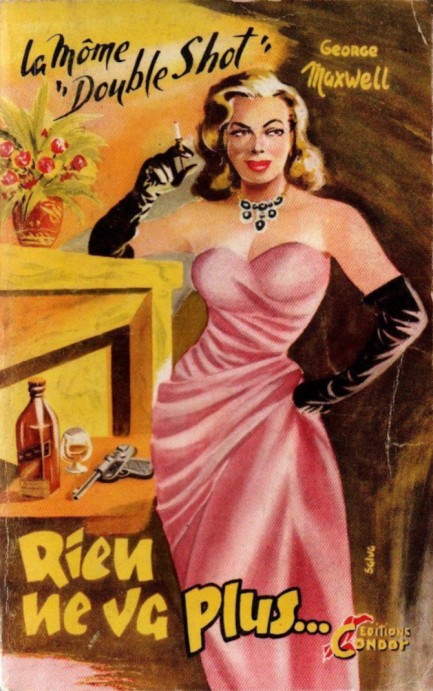
You've seen previous examples from Éditions le Condor's series La Môme Double-Shot. This entry was written by George Maxwell, aka Georges Esposito, and is called Rien ne va plus, which means “nothing is going well.” But this cover went pretty well. Its creator Jean Salvetti, who signed as “Salva,” painted a visual pun in which “double-shot” becomes a choice between a shot of liquor and a shot of lead. We'll take the booze. Every time. More from Salvetti at his keywords below.
 You'll love this. It's called a body shot and it makes American girls squeal with delight. 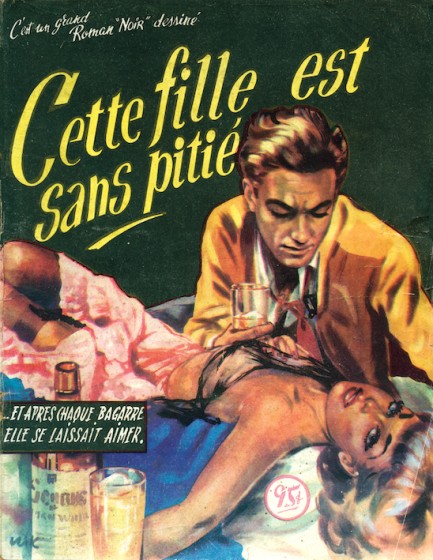
Some things never go out of style. We don't mean body shots. We mean covers by the French artist Jacques Thibésart, aka Nik. He painted the above example for the 1953 crime comic Cette fille est sans pitié! No author is listed on the front, but it was written by George Maxwell, aka Georges Esposito, for Presses Mondiales and its series Les grands romans dessinés. We have a fair amount of Thibésart in the website. Two of his better efforts are here and here.
 Okay, losers. Each of you compliment my très chic pinstriped suit. The least convincing one gets pistol whipped. 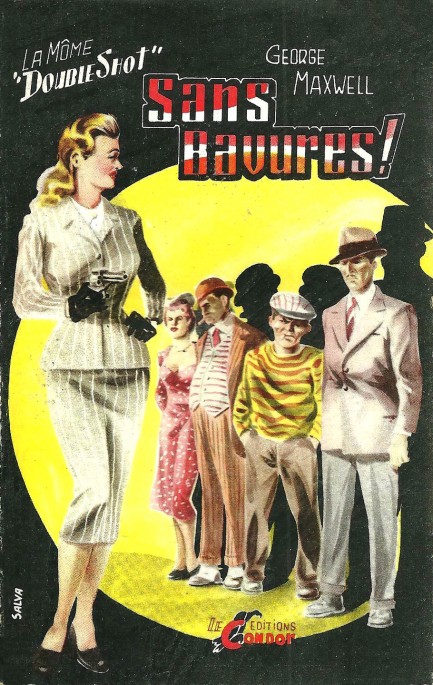
Très chic is a good way to describe not only pin-striped suits on femmes fatales, but covers painted by Jean Salvetti for Éditions le Condor's and George Maxwell's Môme Double-Shot crime novel collection. We've shared five or six, and they're magnifique, including this one for 1952's San bauvures. Maxwell's star character in these was Hope Travers, and hope is exactly what she denies her enemies. She even once put out a cigarette on a guy's face. You can see that cover and others by clicking the keywords Éditions le Condor below.
 For you this is just a light, but for me it's the beginning of a toxic sexual obsession and eventual restraining order. 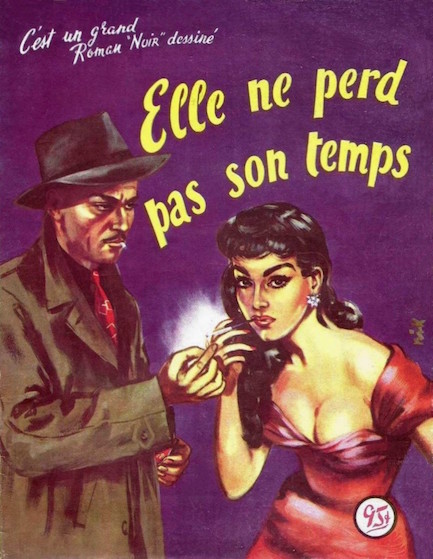
We're going to do one more entry on France before we head to other countries. Once we have time to do some intensive scanning you'll see the bulk of our Paris treasures. Paris, by the way, is a city where strangers often ask you for a light, which is why we thought of the above subhead. If we actually smoked it would be a great way to meet people, but since we never have an actual light all interaction ends there. So while we learn how to smoke, above you see a cover for Elle ne perd pas son temps, by George Maxwell, aka Georges Esposito, for Presses Mondiales and its series Les grands romans dessinés, published in 1953. These were comic books adapted from the series La Môme Double-Shot, specifically 1952's La belle se joue à deux, which you can see here. Elle ne perd pas son temps translates to “She doesn't waste her time,” and neither did the artist Jacques Thibésart, aka Mik, when he painted this nice cover. If you're inclined you can see examples from him here, here, and here, and you can certainly expect more in the future.
 If you think this is painful wait until I tell you all the kinky things I did with your husband. 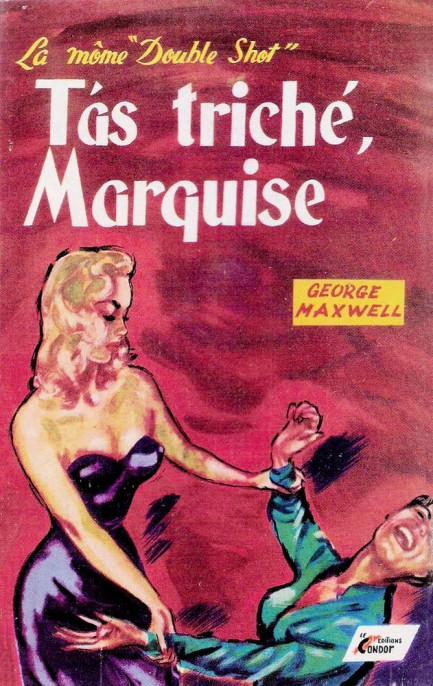
T'as triché marquise was written by the pseudonymous author George Maxwell and published in 1953 as part of Editions le Condor's collection La Môme Double-Shot. This is one of the more violent entries in the series and the cover art reflects that. What we like best about it is how effortless the blonde makes her submission hold on the brunette look. Not a single golden hair has moved. Many of these Double Shot covers were painted by Jean Salvetti, but this one is by Jacques Thibésart, also known as Nik, or more likely Mik (we're still avoiding changing all those old posts but we'll get around to it). In any case, fine work.
 Secondhand smoke is the least of his problems. 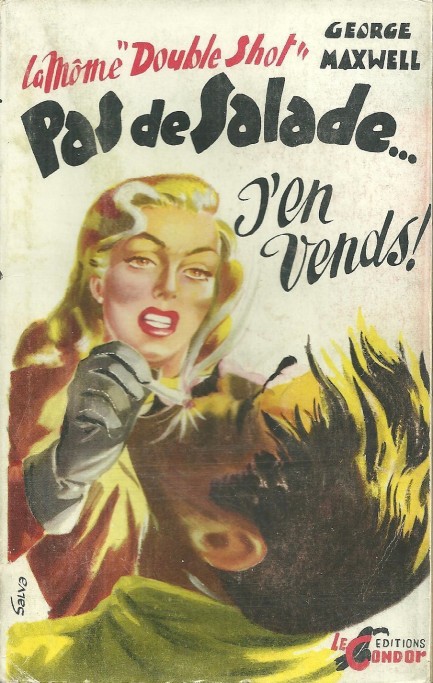
Above is another entry from Éditions le Condor’s collection Môme Double-Shot, Pas de salade, j’en vends!, appearing in 1953, with badass heroine Hope Travers showing how useful a lit cigarette can be. The cover art is by Jean Salvetti, and you can see other covers of his from this series here, here, and here.
 She’s one red hot môme. 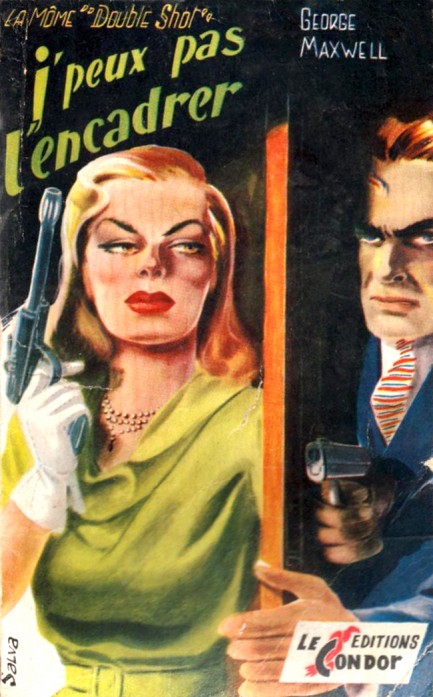 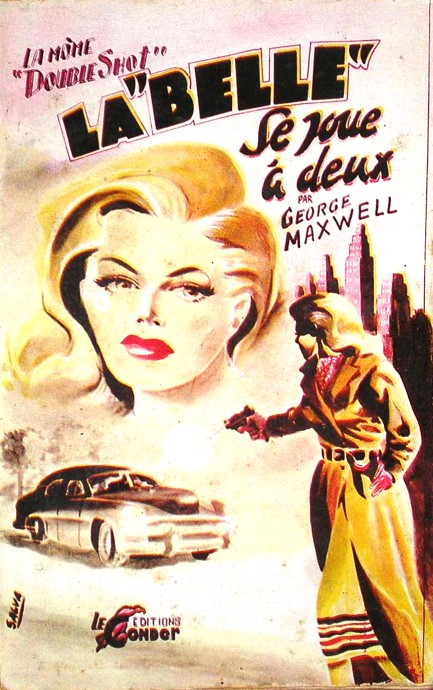
We’ve shared several examples from Éditions le Condor’s collection Môme Double-Shot, which as we’ve discussed was written by George Maxwell, aka Georges Esposito, and deals with the adventures of gun-toting heroine Hope Travers. Today we thought we’d share two more. Above you see covers for La belle se joue à deux and J’peux pas l'encadrer, both with art by Jean Salvetti, aka Salva. We love these. Besides the art being so striking, there’s a lot of charm added by the haphazard freehand lettering. If you want to see more from this series, just dig around our site. They’re in here somewhere.
 Big trouble in little Chinatown. 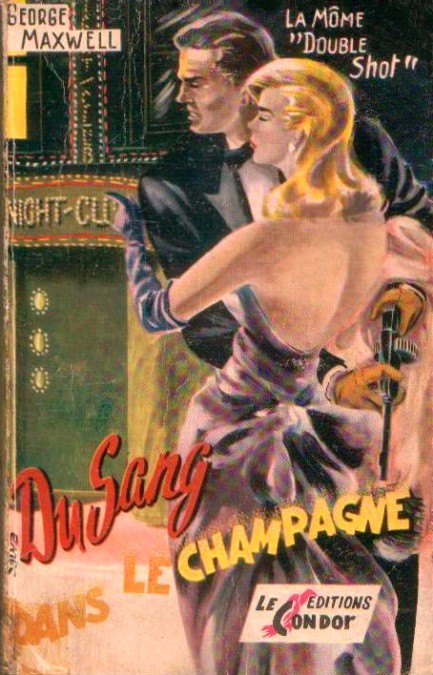
Du Sang dans le Champagne translates in English to Blood in the Champagne, and that's always something to avoid. This paperback dates from 1953 and is part of Éditions le Condor’s collection La Môme “Double Shot,” a series you shoud be getting to know pretty well, since we've recently shown you two other examples. George Maxwell wrote twenty-two books in this franchise in two years, which is simply amazing output, quality notwithstanding. In this one murder and mystery takes the hero Hope Travers to L.A.’s Chinatown, where she goes up against a shadowy organized crime sect. The cover art is by Salva, aka Jean Salvetti, as usual. See the other Double Shot covers by clicking the keywords Éditions le Condor just below.
 I warned you two I could keep this up forever. 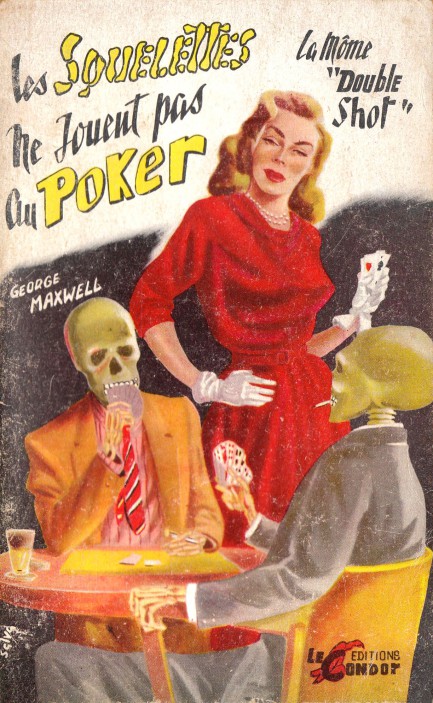
We shared an example from Éditions Le Condor’s series La Môme “Double Shot” back in September and today we have another—1953’s Les squelettes ne jouent pas au poker by George Maxwell. The translation of the title is rather funny—“skeletons don’t play poker.” The art, by Jean Salvetti once again, would seem to suggest otherwise.
 The deadliest shot in Tinseltown. 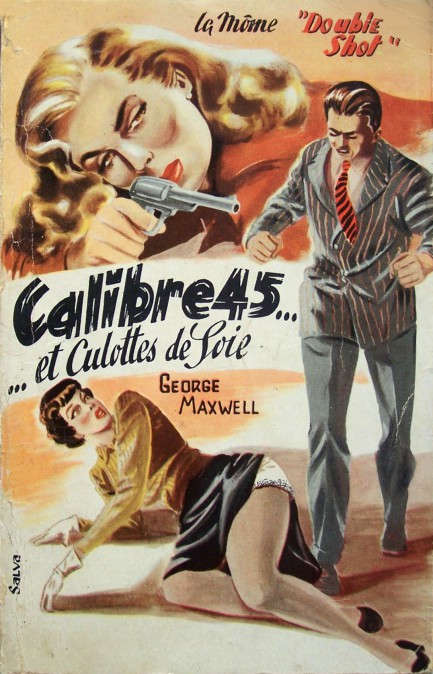
Above, the cover of Calibre 45… et culottes de soie, by George Maxwell for Éditions le Condor’s collection La Môme Double Shot. The English title of this would be something like “Calibre .45 and silk panties,” and if you’re thinking only a Frenchman could come up with something like that you’d be right, because Maxwell was, of course, a pseudonym. It was inhabited by numerous writers, but in this case was used by Georges Esposito to pen a story set in Hollywood and starring the character Hope Travers, whose skill with a sidearm makes her someone not to be trifled with—hence “Kid Double Shot.” There were twenty-two books in the series. The cover art on this one and most of the others is by Salva, aka Jean Salvetti, who we’ll have more from later. The book appeared in 1953

|
 |

The headlines that mattered yesteryear.
2003—Hope Dies
Film legend Bob Hope dies of pneumonia two months after celebrating his 100th birthday. 1945—Churchill Given the Sack
In spite of admiring Winston Churchill as a great wartime leader, Britons elect
Clement Attlee the nation's new prime minister in a sweeping victory for the Labour Party over the Conservatives. 1952—Evita Peron Dies
Eva Duarte de Peron, aka Evita, wife of the president of the Argentine Republic, dies from cancer at age 33. Evita had brought the working classes into a position of political power never witnessed before, but was hated by the nation's powerful military class. She is lain to rest in Milan, Italy in a secret grave under a nun's name, but is eventually returned to Argentina for reburial beside her husband in 1974. 1943—Mussolini Calls It Quits
Italian dictator Benito Mussolini steps down as head of the armed forces and the government. It soon becomes clear that Il Duce did not relinquish power voluntarily, but was forced to resign after former Fascist colleagues turned against him. He is later installed by Germany as leader of the Italian Social Republic in the north of the country, but is killed by partisans in 1945.
|

|
|

It's easy. We have an uploader that makes it a snap. Use it to submit your art, text, header, and subhead. Your post can be funny, serious, or anything in between, as long as it's vintage pulp. You'll get a byline and experience the fleeting pride of free authorship. We'll edit your post for typos, but the rest is up to you. Click here to give us your best shot.

|
|


























































































